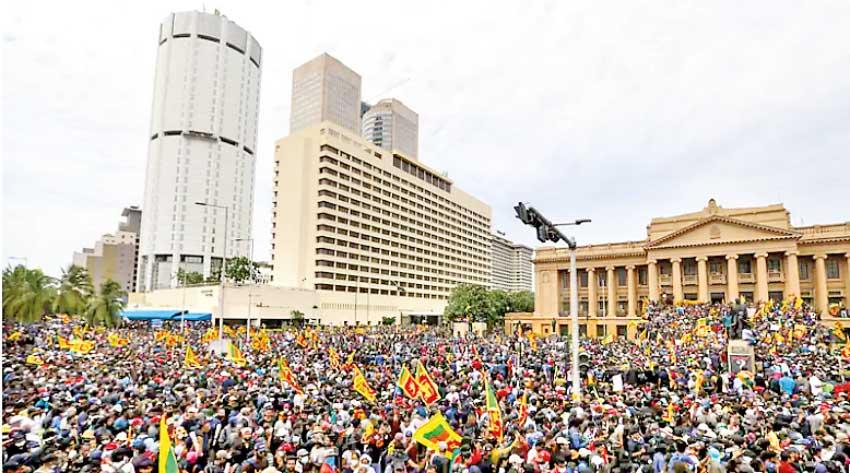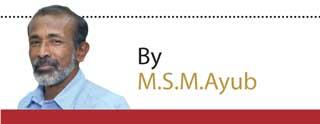16 Jul 2022 - {{hitsCtrl.values.hits}}

Protestors participate in an anti-government demonstration outside the President's office in Colombo on July 9, 2022. | (Photo by AFP)
 The government which earlier retreated in the face of the people’s uprising against it now seems to have determined to take the bull by the horns and defeat it. It is not clear if this is the result of the government exhausting its patience or the change of leadership after President Gotabaya Rajapaksa left the country on account of the uprising intensifying.
The government which earlier retreated in the face of the people’s uprising against it now seems to have determined to take the bull by the horns and defeat it. It is not clear if this is the result of the government exhausting its patience or the change of leadership after President Gotabaya Rajapaksa left the country on account of the uprising intensifying.
When angry crowds flocked in their thousands near the private residence of President Gotabaya Rajapaksa on March 31 and when thousands of people launched a permanent protest site in front of the Presidential Secretariat at Galle Face Green on April 9, the President or the government was reluctant or feared to take harsh action against them. However, Prime Minister Ranil Wickremesinghe as the Acting President imposed an island wide state of emergency and curfew first in the Western province and later throughout the country on Wednesday to handle the anti-government protests. He also ordered the security forces and the police to clear the Galle Face Green, Presidential Secretariat and the Temple Trees of protesters who had occupied those three sites.
The dates of the milestones of the uprising or the “Aragalaya” as it is now commonly known are very interesting. After the surrounding of the President’s residence the protesters on April 9 set up the protest site at Galle Face green which they later named GotaGoGama. Mahinda Rajapaksa resigned on May 9 as Prime Minister amidst reprisal attacks on his supporters who had attacked the protesters at Galle Face and in front of Temple Trees, the Prime Minister’s official residence.
On June 9, former Finance Minister Basil Rajapaksa, the youngest in the Rajapaksa family resigned as a Parliamentarian as the pressure on the government mounted with the worsening of the economic crisis. And finally, as massive crowds occupied the historic President’s House, Presidential Secretariat and Temple Trees on July 9, President Gotabaya Rajapaksa went into hiding and announced his intention to resign. He informed Speaker Mahinda Yapa Abeywardena that he would relinquish his position on July 13 but instead fled to Maldives on a air force jet in the early hours of the said date.
Earlier on May 9, Mahinda Rajapaksa also had to take refuge at a naval base in Trincomalee after tendering his resignation as Prime Minister amidst violence which erupted in many parts of the country following his supporters attack on the protesters. President Gotabaya Rajapaksa’s reluctance to tender his resignation straightaway despite the announcement of it on July 9 has been attributed to various theories floated by various groups. The most credible one of them is that he wants to ensure himself of his security before he relinquishes power.
With the President announcing his resignation on July 9 Ranil Wickremesinghe said that he would resign as the Prime Minister after handing over the responsibilities to an all-party government which is yet to be formed. This resulted in a huge agitation by the protestors calling his immediate resignation. During the melee his house was torched and the Prime Minister’s office was also occupied by the protesters.
The July 9 uprising was the biggest demonstration of strength by the people against the government and it was not organised by a particular political party or a group but the response by the people enraged by the current economic crisis to the calls by various political and social media groups.
Despite President Gotabaya Rajapaksa and his wife having fled the country, the immediate political aspiration of the people and the protesters – a change in the government – is yet to be achieved. Even if it is achieved, the much touted “system change” seems to be extremely remote due to various reasons. Firstly, the traditional political parties in Parliament have been waiting for the situation to calm down in order to carry out their political agendas. Secondly due to their heterogeneity, the main agitating groups have failed to arrive at an agreement on a post-uprising programme of action.
Thirdly, even if there is such a programme those groups do not have any legal status or power to implement it. Despite them having ignored the Constitution and the other laws up to the point of ouster of the President, they cannot continue to do so when it comes to implementation of such a programme. Fourthly, there appears to be a lack of coordination between them and the traditional political parties and the Parliament in order to get their programme implemented through the traditional political mechanism.
The leaders of the parties representing the Parliament, immediately after the President communicated his intention to resign to the Speaker, decided to form an interim all-party government. They, especially the small parties have been calling for the establishment of such a government since April. Yet, it is not the structure of the government that matters most at this juncture, but a programme of action to address the immediate issues that affect the lives of the people of the country. Therefore, an all-party government would also earn the wrath of the people very soon as no party has thus far presented such a programme.
The protesters are comprised of the various organisations affiliated to the Janatha Vimukthi Peramuna (JVP) and the Frontline Socialist Party (FSP), social media groups that have been popular due to the anti-government campaign they have been carrying out for the past several months and the general public who have been enraged by the hardships they have to undergo due to the current economic downturn. All these groups had been in a spontaneous agreement to act against the government but cracks seem to have begun to emerge among them with the government succumbing to their pressure.
The clash between two of these groups reportedly over the sharing of a room at Temple Trees early this week was in fact the manifestation of the ideological difference between them. In another incident one group of protesters had submitted a list of 25 names to political parties representing Parliament as the representatives of protesters for a discussion between the two sides. Then another group questioned as to who those 25 individuals are and who authorized their names as representatives of the “Aragalaya.”
Following the occupation of the President’s House and the Temple Trees a group of protestors had forced a private TV station to have an interview with them and expressed hope during the interview that an all-party government would be formed. However, a prominent leader of another group of protesters told media that they did not toil for the politicians who robbed the country so far to form an all-party government. The mob attack on JVP politburo member Wasantha Samarasinghe while making a speech at the Galle Face Aragalaya site on Wednesday points to the intensity of the differences among various groups of protesters.
The Protesters occupied the President’s House and other government buildings forcefully instilling fear among the leaders which prompted the President to announce his resignation while in hiding. It might be against the law of the land despite it being endorsed by the large majority of people in the country. However, after the ouster of the President, nobody expects them to go against the law. Their actions must conform to the Constitution and the other relevant laws. That is the challenge now they are faced with. They have to develop a mechanism to have a dialogue with the political parties and the Parliament in order to implement their demands.
However, there is a vast communication gap between them and the traditional political machinery – the Parliament. The FSP has suggested to form a “People’s Council” to fill the gap and some political parties have welcomed the idea. Whatever the mechanism may be, the protesters as well as the political parties have to act fast to avert a humanitarian as well as a political disaster.
27 Nov 2024 19 minute ago
27 Nov 2024 2 hours ago
27 Nov 2024 2 hours ago
27 Nov 2024 2 hours ago
27 Nov 2024 3 hours ago